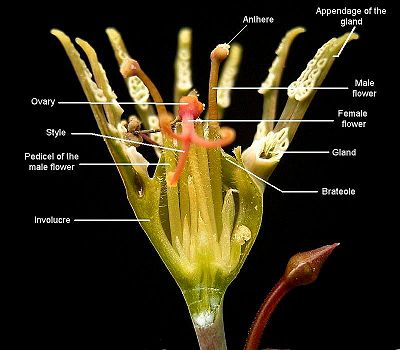
Cyathium
Encyclopedia

Pseudanthium
A pseudanthium or flower head is a special type of inflorescence, in which several flowers are grouped together to form a flower-like structure. The real flowers are generally small and greatly reduced, but can sometimes be quite large...
("false flowers") forming the inflorescence
Inflorescence
An inflorescence is a group or cluster of flowers arranged on a stem that is composed of a main branch or a complicated arrangement of branches. Strictly, it is the part of the shoot of seed plants where flowers are formed and which is accordingly modified...
of plants in the genus Euphorbia (Euphorbiaceae
Euphorbiaceae
Euphorbiaceae, the Spurge family are a large family of flowering plants with 300 genera and around 7,500 species. Most are herbs, but some, especially in the tropics, are also shrubs or trees. Some are succulent and resemble cacti....
). A cyathium consists of:
- Five (rarely four) bracteoles. These are small, united bractBractIn botany, a bract is a modified or specialized leaf, especially one associated with a reproductive structure such as a flower, inflorescence axis, or cone scale. Bracts are often different from foliage leaves. They may be smaller, larger, or of a different color, shape, or texture...
s, which form a cup-like involucre. Their upper tips are free and in the beginning cover the opening of the involucre (like the shutter of a camera). These alternate with: - Five (1 to 10) nectar glands, which are sometimes fused.
- One extremely reduced female flower standing in the centre at the base of the involucre, consisting of an ovaryOvary (plants)In the flowering plants, an ovary is a part of the female reproductive organ of the flower or gynoecium. Specifically, it is the part of the pistil which holds the ovule and is located above or below or at the point of connection with the base of the petals and sepals...
on a short stem with pistil, and surrounded by: - Five groups (one group at the base of each bracteole) of extremely reduced male flowers, which each consist of a single anther on a stem.
The flower-like characteristics of the cyathia are underlined by brightly coloured nectar glands and often by petal
Petal
Petals are modified leaves that surround the reproductive parts of flowers. They often are brightly colored or unusually shaped to attract pollinators. Together, all of the petals of a flower are called a corolla. Petals are usually accompanied by another set of special leaves called sepals lying...
-like appendages to the nectar glands, or brightly coloured, petal-like bracts positioned under the cyathia. The paired petal-like bracts in the sub-family Euphorbia section Goniostema are called cyathophylls.
The cyathia are sometimes solitary, but are usually in cymes, inflorescences of the second order, in pseudumbels, on dichotomously branched stalks or in so-called simple cymes which consist of one central and two lateral cyathia.
In one group of Madagascan species in the sub-family Euphorbia section Goniostema (E. aueoviridiflora, E. capmanambatoensis, E. iharanae, E. leuconeura, E. neohumbertii, E. viguieri) there is a tendency for a further pseudanthium to grow from the cyme. Probably as an adaptation to pollination by bird
Bird
Birds are feathered, winged, bipedal, endothermic , egg-laying, vertebrate animals. Around 10,000 living species and 188 families makes them the most speciose class of tetrapod vertebrates. They inhabit ecosystems across the globe, from the Arctic to the Antarctic. Extant birds range in size from...
s, the cyathia have become specialised: Most cyathia have upright cyathophylles which surround them protectively, but render the nectar glands inaccessible. To compensate, between them are naked sterile cyathia whose only job is to produce nectar.

